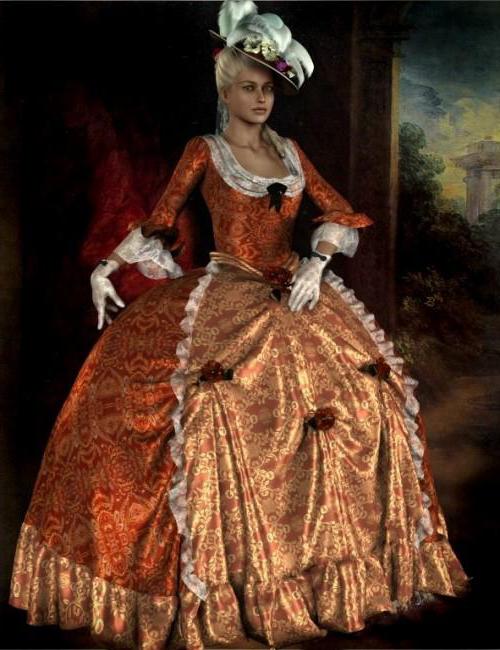
It will not be a secret for anyone thatClothing is the so-called mirror of time. For example, old dresses can reflect both fashionable, and philosophical, political, cultural and other trends of a certain era. Each of them stands out with its own ideals of female beauty, expressed in all sorts of outfits and various accessories. Since its appearance in the world, ancient dresses have undergone a dramatic number of changes. So, more in detail.

Old dresses appeared in Europe in the early Middle Ages (6-10th century). Male power began to be contrasted with female beauty. Accordingly, the clothing of the opposite sexes was divided.
In the 11th and 12th centuries (in the Roman period) dressesThe old ones were cut using three seams (two side and middle on the back). This made it possible to fit the bodice in the figure. The lower part was widened at the expense of the wedges.
In the era of the late Middle Ages (in the 13th and 15th centuries)modeling and designing of clothes began to develop very intensively. In the fashion included darts and removable sleeves, connecting with armhole with tape or lacing.
15-16th century (Renaissance) - the periodthe celebration of Italy. The lawmakers adopted new canons of beauty as a basis, which have retained their relevance to this day. That is, a stout figure, a thin waist, high growth. Women's dresses were a long skirt and a lace with a lacing, tight fitting body. The decollete, as a rule, had a rectangular or oval shape.

In the 17th century, Baroque style was born in Italy. Its main features were pretentiousness, splendor and decorativeness. Women stressed their clothing high growth, lush breasts and thighs, thin waist.
Dresses of the 18th century - models in the Rococo style. This time, the splendor gave way to fragility. Women created "puppet" images. The presence of a corset was mandatory. The 18th century dresses were made of the most fashionable materials at that time: velvet, brocade, satin, moire, ratina and cloth. The color scheme was chosen light, clean, tender. Decorations were decorated with a large decorative ornament: flowers, curls, leaves.

The 19th century was the era of the formation of principlesrealism and utilitarian thinking. These changes reflected in themselves and every ancient female dress of that period. The century began with slightly theatrical dresses. He ended up comfortable and pragmatic.
In general, at the beginning of the century grotesque and magnificentThe Rococo style was replaced by a simple empire. Because instead of complex outfits, women wore translucent dresses made in Greek style. The antique silhouette, similar to one of the harmonious columns of a beautiful Greek temple, was firmly in fashion. The main differences in the outfits of the beginning of the 19th century were an overstated waist, a ribbon under the chest, a deep cutout, sleeves-lanterns, a free skirt with folds. Most often there were red, blue and white tones.
In the 1920s, the Restoration period began. Thalia still remained overstated. However, she was again pulled into a corset. The fashion included skirts shaped bells, lower skirts and a metal frame.
A special splendor and richness of dress finishingacquired with the accession to the throne of Queen Victoria. Romanticism, dreamy, spiritualized, sublime images are the distinctive features of this period. The fashionable silhouette of the "hourglass" was created with the help of an elegant corset, a skirt on the crinoline and lush wide sleeves on the frame.

In the 60's, old long dresses were decoratedpatterned border, denticles, festoons, volan. In diameter, the hem gradually reached three meters. This period was called the "second Rococo". Dresses were worn with graceful hats and caps, gloves, shawls, boas, clutches and jewelry.
In the 70's, a fashion bustle - a smallskeleton and a pillow, designed to be placed behind them under the hem of the outfit. This allowed to give the figure a splendor. At the back of the dress were decorated with drapes, folds and ruches.
Well, at the end of the 19th century, the production of clothingbegan to develop even more actively. The range of fabrics has expanded enormously. Began to open the first fashion houses. Gradually, fashion began to go lush skirts. They were replaced by straight, more severe silhouettes. In short, the fashion is changeable. Therefore today we wear quite different styles, and with admiration we look at the images of luxurious old clothes.
